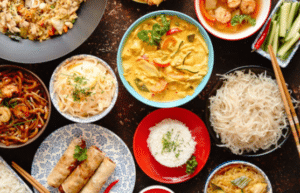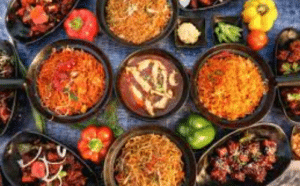Chinese Food is one of the most diverse and beloved culinary tradition
INTRODUCTION OF CHINESE FOOD:

Chinese food is one of the most diverse and beloved culinary traditions in the world, renowned for its bold flavors, diverse ingredients, and rich cultural heritage. From savory stir-fries to delicate dumplings, Chinese food offers a tantalizing array of dishes to satisfy every palate. Let’s explore some of the most iconic and popular dishes in Chinese food,
1. Kung Pao Chicken: A classic Sichuan dish featuring tender chunks of chicken stir-fried with peanuts, vegetables, and chili peppers in a flavorful sauce made with soy sauce, ginger, garlic, and Sichuan peppercorns.

2. Fried Rice: A versatile and satisfying dish made by stir-frying cooked rice with vegetables, eggs, and a variety of proteins such as chicken, pork, shrimp, or tofu, seasoned with soy sauce and other spices.
3. Sweet and Sour Pork: Crispy pieces of pork are coated in a tangy sweet and sour sauce made with vinegar, sugar, ketchup, and soy sauce, then stir-fried with bell peppers, onions, and pineapple for a delightful combination of flavors and textures.

4. Dim Sum: Dim Sum refers to a variety of bite-sized dishes served in steamer baskets or on small plates, including dumplings, buns, rolls, and other savory snacks. Popular dim sum dishes include steamed dumplings, barbecue pork buns, shrimp dumplings, and turnip cakes.
5. Peking Duck: A famous Beijing specialty, Peking Duck features succulent slices of roasted duck served with thin pancakes, scallions, cucumber, and hoisin sauce, allowing diners to assemble their own wraps bursting with flavor.

6. Mapo Tofu: A spicy and flavorful Sichuan dish made with soft tofu cubes cooked in a fiery sauce made with fermented black beans, chili paste, garlic, and Sichuan peppercorns, topped with minced pork and green onions.
7. Chow Mein: A popular Cantonese dish featuring stir-fried noodles tossed with a variety of vegetables, meats, and seafood in a savory sauce made with soy sauce, oyster sauce, and sesame oil.
8. Hot and Sour Soup: A hearty and comforting soup made with chicken or pork broth, tofu, mushrooms, bamboo shoots, eggs, and a variety of spices and seasonings such as vinegar, soy sauce, and white pepper, creating a perfect balance of flavors.

9. Ma Po Tofu: Another iconic Sichuan dish, Ma Po Tofu features silky tofu cubes simmered in a spicy, aromatic sauce made with chili bean paste, fermented black beans, garlic, and Sichuan peppercorns, garnished with minced pork and green onions.
10. Spring Rolls: Crispy and golden, spring rolls are a popular appetizer or snack made by wrapping a mixture of vegetables, meats, and sometimes noodles in thin pastry wrappers, then deep-frying until crisp and delicious.
Chinese cuisine is as diverse as the country itself, with each region boasting its own unique flavors, ingredients, and cooking techniques. From the fiery spices of Sichuan cuisine to the delicate flavors of Cantonese dishes, Chinese food offers a rich tapestry of flavors and textures that has captivated food lovers around the world. Let’s take a closer look at some of the key features and characteristics of Chinese cuisine:
11. Regional Diversity: China’s vast size and varied geography have given rise to a wide array of regional cuisines, each with its own distinct culinary traditions. Some of the most well-known regional cuisines include Sichuan, Cantonese, Shandong, Hunan, and Jiangsu, each characterized by unique ingredients, flavors, and cooking styles.
12. Balance of Flavors: Chinese cuisine is renowned for its emphasis on achieving a harmonious balance of flavors, textures, and colors in every dish. Traditional Chinese cooking often seeks to balance the five key flavors: sweet, sour, bitter, salty, and umami, creating a complex and satisfying culinary experience.
13. Stir-Frying and Wok Cooking: Stir-frying is one of the most common cooking techniques in Chinese cuisine, involving quickly cooking ingredients in a hot wok over high heat. This method preserves the natural flavors and textures of the ingredients while allowing for fast and efficient cooking.
14. Importance of Fresh Ingredients: Freshness is paramount in Chinese cooking, with an emphasis on using seasonal, locally sourced ingredients whenever possible. Fresh vegetables, herbs, and meats are prized for their vibrant flavors and nutritional value, and many Chinese dishes highlight the natural qualities of the ingredients.
These are just a few examples of the diverse and delicious offerings found in Chinese cuisine. Whether you’re craving something spicy, savory, or sweet, there’s sure to be a Chinese dish that will tantalize your taste buds and leave you craving more.
Find Chinese food near your location:
- Search Online Maps: Use Google Maps, Apple Maps, or any other mapping service and simply type in “Chinese food” or “Chinese restaurants” followed by your current location. The map will show you nearby options along with their ratings, reviews, and directions.
- Restaurant Apps: Many food delivery apps such as Uber Eats, DoorDash, Grubhub, and Postmates allow you to search for nearby restaurants based on your location. Simply enter “Chinese food” in the search bar, and the app will display various options available for delivery or pickup.
- Online Reviews: Websites like Yelp, TripAdvisor, and Zomato provide listings and reviews for restaurants in your area. You can search for Chinese restaurants and read reviews from other customers to help you decide which one to try.
- Social Media Recommendations: Consider asking for recommendations on social media platforms like Facebook, Twitter, or Instagram. Your friends or followers may have favorite Chinese restaurants they can suggest, or you might find local food groups or pages dedicated to restaurant recommendations in your area.
- Local Directories: Check local business directories or community websites that list restaurants in your area. These directories often categorize businesses by cuisine type, making it easy to find Chinese restaurants nearby.